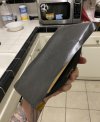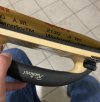Hello,
as I've already stated on the forums, I am quite new to sharpening, but I've sharpened a few knives and tools now (carbon or stainless). I am sharpening my knives on sandpaper with edge trailing technique with success. Today I noticed that my Tops CAT is seriously dull and can't cut things like flowers without problem. So, I've picked up 800 and 1200 grit sandpaper and I've been sharpening on bot of them for at least 4 hours, but the sharpness is only insignificantly higher. I tried the sharpie thing and I am sharpening all the way to the edge evenly. Where is the problem exactly? Should I try lower grit? I've been unable to build a burr and bring the knife to hairsplitting sharpness before, but it at least sliced paper and I don't really know where the problem could be now. Can you determine the edge and the burr by optical means at home somehow?
as I've already stated on the forums, I am quite new to sharpening, but I've sharpened a few knives and tools now (carbon or stainless). I am sharpening my knives on sandpaper with edge trailing technique with success. Today I noticed that my Tops CAT is seriously dull and can't cut things like flowers without problem. So, I've picked up 800 and 1200 grit sandpaper and I've been sharpening on bot of them for at least 4 hours, but the sharpness is only insignificantly higher. I tried the sharpie thing and I am sharpening all the way to the edge evenly. Where is the problem exactly? Should I try lower grit? I've been unable to build a burr and bring the knife to hairsplitting sharpness before, but it at least sliced paper and I don't really know where the problem could be now. Can you determine the edge and the burr by optical means at home somehow?


